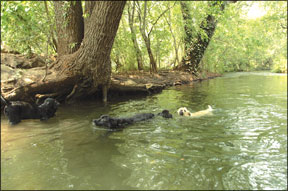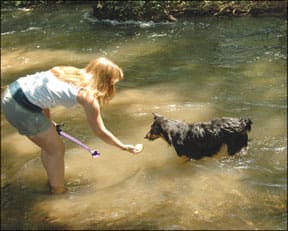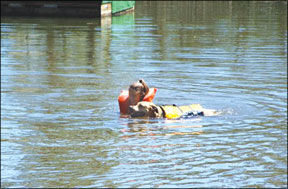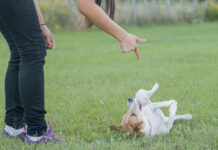For those of us who regularly swim for fitness, we know why swimming is often referred to as “the perfect exercise.” In addition to the physical benefits shared with other forms of aerobic exercise, swimming offers some unique benefits. It eliminates the effects of weight-bearing on the joints, exercises the entire body – upper and lower – at the same time, and, in most cases, is something we can do for our entire lives, even if age precludes us from taking part in other forms of exercise.
The physical benefits of swimming are the same for your canine companion as they are for you – that is, if you have a dog who will swim. Even though they actually have a stroke named after them, the notion that all dogs are “natural swimmers” is an erroneous one.

Some breeds were developed to work in water and are more physically adapted for swimming than others. The problem here is not getting these dogs into the water, but keeping them on terra firma when we want them to stay clean and dry. However, occasionally, even a water breed shows disdain for water – yes, there are some Labrador Retrievers who hate swimming.
Conversely, there are dogs you’d never imagine taking kindly to the water who become devoted and skilled swimmers. Although not blessed with the physical advantages of a water breed, and despite sinking rear ends or heavy, wet coats, these Boston Terriers, Rhodesian Ridgebacks, and Siberian Huskies have learned to enjoy swimming. They don’t know or care that they have to work a little harder than a Poodle, Cocker Spaniel, or a Newfoundland – they just want to have fun!
Some dogs may simply not like the sensation of being in water. But many dogs fear the water for precisely the same reason that many humans do: they don’t know how to swim! But suppose you could help your dog overcome his dislike, or fear, of water by teaching him how to swim? Think of the years of fun ahead for your dog if he learns to love the water. It’s also a skill that may come in handy someday when you need to rehabilitate an injury your dog has sustained, or when joint disease makes weight-bearing exercise too painful. And if you live near or on the water, or own a pool, teaching your dog to swim becomes a matter of safety.
Swimming lessons
We know that introducing a young puppy to all sorts of novel stimuli is important in developing a well adapted, socialized adult dog. Puppies between the ages of roughly 6 to 16 weeks more easily overcome fears of new objects, people, and situations than will older puppies and dogs.
Exposure to water is no exception. If you have a young puppy, take advantage of this period to get your puppy used to the water and to teach him to swim. If you have an older puppy or adult dog, even one who already has shown a dislike for the water, you may still be able to teach your dog to swim and enjoy it. It just may take a little longer. Some dogs take to swimming almost immediately. Others may take weeks before they feel confident.
There is no faster way to make a dog fear water than to drop him into it. Believing all dogs are “natural swimmers,” there are people who try to teach their dogs to swim by doing exactly this. Never drop your dog into water; it is cruel and may quickly end his swimming career before it starts. You will want to accompany your dog into the water to teach him to swim, so dress accordingly – anything from bare feet and rolled-up pants to a bikini will work! Expose your dog gradually to water, whether a pool, stream, pond, lake, or the ocean. The focus of your training is to teach your dog to enjoy being in water. To make the experience as positive as possible, be sure the conditions are optimal – a warm day, warmer water temperature, shallow entry to the water, and little distraction.
Pond or lake shorelines are ideal for getting your dog accustomed to being near the water. Walk slowly along the shoreline with your dog on-leash. If he is clearly uncomfortable with your proximity to the water, move a bit farther away. Praise your dog as he walks with you, feeding him treats that are especially yummy, or coaxing him and rewarding him with a coveted toy (preferably one that is waterproof and floats).
Advance only when ready
When he is clearly comfortable walking along the shoreline at a distance from the water, try walking a little closer to the water. Continue to praise him lavishly and reward him the treats or a toy. When your dog progresses to moving closer to the water with no signs of anxiety, try continuing your stroll at the water’s edge. Walk in an inch or two of water and allow your dog to get his feet wet. Make a fuss over his bravery.
Unless your dog shows an interest in wading into deeper water on his own, this is a good place to stop training for the day. End on a positive note. If you are successful in helping your dog feel comfortable just being close to the water, you’ve had a good first day of training. Your dog is beginning to learn that good, fun things happen around the water!

Your next step is to encourage your dog, with treats or a toy, into venturing a little deeper. Continue to walk, play, praise, and treat, gradually increasing the depth of the water to no higher than your dog’s belly. Watch closely for any signs of anxiety, and if present, return to a depth where your dog is having fun and is relaxed and comfortable.
Once your dog is comfortable in water that is up to his belly, it is time to begin the real swimming lesson. Place your hands underneath your dog’s midsection and hindquarters for support, suspend him in the water and move him slowly forward into deeper water for a foot or two. He should soon start paddling as you support him and move him through the water. His stroke technique won’t be pretty at first – he may claw the air above the water with his front paws and barely move his hind legs – but with repetition, his form will improve.
Relax and speak calmly and happily to your dog while moving him through the water. Return him to where he was standing previously – and praise and reward him. You may even move him toward his favorite floating toy and allow him to snatch it up as a reward.
Up a creek with a paddle
When your dog is paddling gracefully with his front paws as well as with his hindquarters, it’s time to have your dog try to swim on his own. Encourage your dog to swim to you for a short distance in water that is a little over his head. Use a treat or a toy to lure him and reward him. See if he will swim back in on his own as well, with you leading the way. If he is not ready to swim on his own, spend more time getting him comfortable paddling with your hands supporting him.
As your dog becomes accustomed to swimming on his own for short distances, you may try tossing his toy out a little farther, or calling him to you from farther away.
Keep your dog on-leash during the training in case he gets distracted or confused and has difficulty reaching shore. A harness on your dog is preferable to a collar for attaching the leash. If you have to help your dog reach the shore by gently pulling on the leash, using a harness will prevent stress on your dog’s neck and will not interfere with his ability to hold his head above water. Use a longer leash or nylon line for safety as your dog swims for increasing distances, adjusting the slack as he swims so he doesn’t become entangled.
For the occasional inexperienced but confident puppy or dog you may be able to shorten the swim training process. Introduce your dog to the water by bringing along a canine friend who already swims. Your dog may very well follow his friend into the water and even attempt to swim on his own. Just be prepared to help if your brave dog exceeds his abilities. Keep him on a leash or line, and be close by in case he needs you to support him while he perfects his doggie paddle.
If you are training your dog to swim in a pool, the process is the same. Train gradually around the pool, at the pool’s edge, on the first step or ramp into the pool, then slowly progress to moving him into the water while supporting him with your hands.
Swimming uses a lot of energy and is especially tiring until swimming-specific endurance builds. Keep your training sessions short at first, gradually increasing duration.
With practice, your dog will soon be swimming longer distances with ease. When your dog is swimming regularly for exercise, remember to have him take breaks often. Dogs who love to swim will swim to exhaustion, risking hyperthermia and drowning. Always supervise your dog’s swim sessions and be prepared to help if he finds himself in trouble.
Where to swim
Rivers are dangerous places to allow your dog to swim because of the underlying currents in moving water. But swimming pools, lakes, ponds, creeks, and the ocean can all be great places for dogs to swim. Each venue comes with its own list of safety hazards and precautions to insure that your dog survives his water adventures healthy and happy.
■Swimming pools
•If you have a backyard swimming pool, have it securely fenced in to keep your dog (as well as children) out of the pool when you are not actively supervising.
•If your pool is covered when not in use, firmly secure the cover to prevent your dog from slipping underneath.
•Alarm systems are available that alert when the surface of the water in your pool is broken. Or you can get an alarm that attaches to your dog’s collar and alerts when submerged. (See “Resources,” page 24, for contact information for these and other products mentioned in this article.)
•Your pool should have a ramp or graduated steps for your dog to be able to exit the water. Dogs cannot use ladders! If your pool has no usable exit for your dog, install an escape tool for pets, such as a Skamper-Ramp. Teach your dog where to exit the pool. If your dog falls in the pool and cannot get out, he will eventually tire of paddling and drown.
•If your pool is chlorinated, hose off or bathe your dog after he swims. Chlorine can dry his coat and skin and make him sick if he licks himself. Don’t allow your dog to drink the chlorinated pool water; keep a bowl of fresh water poolside.
•Don’t have your own pool? If the idea of your dog swimming in a clean, confined, safe area appeals to you, check to see if there are any indoor doggie swimming pools or pet therapy pools in your area. You may be able to pay by the hour for use of the pool for one or multiple dogs.
If you live in a colder climate, indoor swimming is an option for continuing your dog’s favorite activity in the cold winter months. These pools are kept fairly warm (75 degrees or more), making the water more comfortable for older dogs and tentative new swimmers.
■Lakes and ponds
•Even the most skilled canine swimmers may become distracted or confused and get lost in a larger body of water. Outfit your dog with a pet flotation device, keep her in your sights at all times, and be prepared to enter the water and help her if needed. Attaching a long leash or line to your dog will always keep you connected.
•Blue-green algae in ponds and lakes is toxic if ingested. An overgrowth of blue-green algae causes the water to appear cloudy with a blue-green hue. Avoid water that is contaminated with blue-green algae; if you suspect that your dog has had contact with or swallowed contaminated water, call your vet immediately.
•Although not all types of algae are toxic to dogs, ponds and lakes in many parks, subdivisions, and golf courses are treated with chemicals to prevent excessive algae growth. Some of these chemicals cause only skin irritation, but others may cause liver damage or neurological damage. Check with the appropriate sources to find out if chemicals are used to treat the water. Call your vet immediately if you suspect chemical poisoning in your dog from swimming in a chemically contaminated lake or pond.
•Lakes and ponds in rural areas may contain herbicides, pesticides, or fertilizers from drainage run-off from local farms. Lakes that allow motor boating may have higher concentrations of petroleum products. Always rinse your dog after swimming in lakes and ponds, and watch for any signs of illness or toxicity.
•While nearly impossible to prevent your dog from drinking the water in his favorite freshwater swimming hole, provide clean water and encourage your dog to drink it. Drinking water from ponds, lakes and streams can lead to an infection of giardia, an intestinal parasite that can cause serious illness.
•If you live in, or are traveling to, a state where alligators live, be aware that they do attack and kill dogs. Keep your dog away from all lakes, ponds, rivers, marshes, wetlands, and swamps. A pool may be your dog’s only option (and you may even want to make sure the pool is reptile-free!).
•Beware of conditions that may injure your dog or put his life at risk. Look for broken glass on the shoreline. Fallen tree limbs in the water that may catch on your dog’s harness or flotation device. Old fishing line underwater may wrap around your dog’s leg. Keep your dog in your vision. If conditions such as water temperature, depth, or distance to your swimming dog would prevent you from safely entering the water to help your dog if needed, you should not allow your dog to swim.
■The ocean
•While many dogs enjoy a romp in the surf at a dog-friendly beach, large waves can knock your dog over and strong tides and undercurrents can pull him under. Or your dog may be so focused on retrieving his drifting ball that he swims out beyond his limits. A doggie life jacket is essential when swimming in the ocean. Attaching a long lead to your dog may prevent you having to swim out after him if he is pulled out to sea.
•Check the water for sea lice and jellyfish. Sea lice can cause red, itchy bumps on your dog’s skin. Jellyfish sting! •Discourage your dog from drinking seawater; it will make him sick. Offer fresh water to him frequently.
•Salt and other minerals in seawater may damage your dog’s coat and irritate his skin. Rinse him off when you leave the beach.
•Keep your dog away from any dead fish or shellfish that have washed ashore.
•Check your dog’s paws for irritation or burning from hot sand on the beach.
■Anywhere
•Be sure your dog has a shady place to rest and plenty of fresh water to drink.
•Dogs can sunburn, especially shorthaired, pink-skinned dogs. Apply sunscreen made for dogs to ears and nose. Avoid prolonged exposure to the sun between the hours of 10 a.m. and 3p.m.
•Heatstroke is also a risk. Familiarize yourself with the symptoms (see “Running with Your Dog,” WDJ February 2009) and take preventive measures; limit your dog’s activity in warmer temperatures and direct exposure to the sun.
•Train your dog to “Come” on cue, even in the water. This may prevent him from swimming too far after a duck or his toy, and you from having to come to his aid.
•Clean and dry your dog’s ears after a swim. While especially important after swimming in dirty lakes and ponds, water retained in the ear creates a hospitable environment for bacteria and yeast to grow, no matter where your dog has been swimming.
•Watch for signs that your dog is tiring. Swimming is a strenuous activity and endurance is achieved slowly. Remember that older dogs, even experienced swimmers, no longer have the strength, agility or endurance that they once had. A tired dog is a good dog on land, but in the water, a tired dog is a dog in big trouble.
•Learn how to take care of your dog if injured when swimming. Organizations that offer courses in Pet CPR and First Aid include the American Red Cross and the American Safety & Health Institute.
Swimming with your dog
Perhaps you’re interested in having your dog swim alongside you so you can work out together. Most people just supervise their dogs when swimming, or wade with them in shallow water. But some folks have their dogs accompany them on swims, and with proper training and conditioning, some dogs progress to swimming long distances with their owners.

Photo by Keith Kerns
My first experience of swimming alongside a dog was many years ago with my Lab, Max. He was so focused on retrieving his ball or stick that he barely paid attention to my presence in the water. He could not have cared less about swimming alongside me; if there wasn’t an object thrown for him to retrieve, or a duck or boat to chase, what was the point of swimming? So I swam alongside him on his retrievals.
Not every dog who swims will swim alongside you willingly. If your dog follows you as you move through the water, that’s a good first step. If he swims to you and claws at you, you have a problem. Try training with a cue such as “Leave it” or “Off” that will let him know not to make physical contact with you. Practice in shallow water at first, with your dog wading beside you, and gradually progress to deeper water where he must swim but you can still walk. Eventually, if you can get him to swim alongside you without contact, slowly increase the distance and duration of your swims. If you breathe to one side when you swim, make sure your dog is always on your breathing side so he remains in your sight.
Landlubbers
My next “swimming” dog was my first Ridgeback, Kimba. I respected his dislike for water after many attempts to acclimate him. But if I would dive off the dock into the lake he would howl and hurl his body into the water after me, seemingly panicked that I was in danger. His stroke consisted of clawing the sky in a frenzy while moving toward me. If I didn’t swim away from him fast enough, my 95-pound personal canine lifeguard would claw me, leaving me bruised and bloodied. I quickly learned to leave him inside when I went for a dip.
So despite your attempts to create a positive association with water, what if your dog would rather have you cut into the quick of a toenail than to venture near the pool or get within sight of the ocean? It’s time to throw in the beach towel and respect your dog’s feelings. Some dogs who don’t take to swimming still enjoy wading and splashing in a kiddie pool or running through a sprinkler to cool off. Even if you are able to teach your dog to swim but he is clearly not enjoying himself, abandon your goal of creating a canine Michael Phelps. Take your dog out for walk, run, or a rigorous game of fetch, and just enjoy being active together.
Susan Sarubin lives, swims, bikes, runs, and trains dogs in Baltimore, Maryland. Her training business is Pawsitive Fit, LLC. Susan is also the Maryland State Coordinator for Rhodesian Ridgeback Rescue, Inc. See her website at pawsitivefit.com for more information.







When I read your article I had an “ah-ha” moment. It seems that whenever the dogs I own age, they have problems with their joints through arthritis or weakness. Thank you for suggesting that swimming is the perfect exercise because it does not have an effect of weight-bearing on the bones and joints. The fact that this works for canines is priceless. Our dog is middle-aged right now. We want to get him into swimming lessons to protect his joints as he ages and still allow him to get exercise.